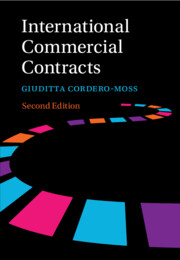546 results
Amended final-offer arbitration over an uncertain value: A comparison with CA and FOA
-
- Journal:
- Experimental Economics / Volume 10 / Issue 4 / December 2007
- Published online by Cambridge University Press:
- 14 March 2025, pp. 439-454
-
- Article
- Export citation
Case Study 6.3 - The Use of Foreign Investment Treaties in the Protection of Chinese Outbound Investments
- from Section 6 - Disputing
-
-
- Book:
- A Casebook on Chinese Outbound Investment
- Published online:
- 28 February 2025
- Print publication:
- 06 March 2025, pp 297-318
-
- Chapter
-
- You have access
- Open access
- HTML
- Export citation
16 - The Impact of Extraterritorial and Secondary Sanctions on Contractual Obligations
- from Part IV - Secondary Sanctions in Commercial Practices and Domestic Litigation
-
-
- Book:
- The Cambridge Handbook of Secondary Sanctions and International Law
- Published online:
- 14 December 2024
- Print publication:
- 12 December 2024, pp 362-404
-
- Chapter
- Export citation
Chapter Four - US Litigation by Chinese Companies
-
- Book:
- Negotiating Legality
- Published online:
- 13 June 2024
- Print publication:
- 27 June 2024, pp 124-158
-
- Chapter
- Export citation
4 - War, Peace and Interstate Relations
-
-
- Book:
- The Cambridge Comparative History of Ancient Law
- Published online:
- 09 May 2024
- Print publication:
- 30 May 2024, pp 146-180
-
- Chapter
- Export citation
40 - Decision-Making in Alternative Dispute Resolution
- from Part V - Other Legal Decision-Making
-
-
- Book:
- The Cambridge Handbook of Psychology and Legal Decision-Making
- Published online:
- 22 February 2024
- Print publication:
- 29 February 2024, pp 617-633
-
- Chapter
- Export citation
2 - The Role of Transnational Law
-
- Book:
- International Commercial Contracts
- Published online:
- 09 November 2023
- Print publication:
- 01 February 2024, pp 39-134
-
- Chapter
- Export citation
5 - Does Arbitration Ensure a Self-Sufficient Contract?
-
- Book:
- International Commercial Contracts
- Published online:
- 09 November 2023
- Print publication:
- 01 February 2024, pp 285-440
-
- Chapter
- Export citation
1 - International Contract Practice and Its Expectations in Terms of the Governing Law
-
- Book:
- International Commercial Contracts
- Published online:
- 09 November 2023
- Print publication:
- 01 February 2024, pp 8-38
-
- Chapter
- Export citation
4 - Which State’s Law Governs an International Contract?
-
- Book:
- International Commercial Contracts
- Published online:
- 09 November 2023
- Print publication:
- 01 February 2024, pp 200-284
-
- Chapter
- Export citation
3 - That Sweet Enmity
-
- Book:
- Athens and Boiotia
- Published online:
- 29 February 2024
- Print publication:
- 25 January 2024, pp 73-171
-
- Chapter
-
- You have access
- Open access
- HTML
- Export citation
United Mexican States v. Burr and Others
- Canada. 20 July 2020
-
- Journal:
- International Law Reports / Volume 205 / 2024
- Published online by Cambridge University Press:
- 20 December 2024, pp. 541-606
- Print publication:
- 2024
-
- Article
- Export citation
B-MEX, LLC and Others v. United Mexican States
- Arbitration Tribunal (NAFTA Chapter 11). 19 July 2019
-
- Journal:
- International Law Reports / Volume 205 / 2024
- Published online by Cambridge University Press:
- 20 December 2024, pp. 1-129
- Print publication:
- 2024
-
- Article
- Export citation
17 - International Dispute Settlement
- from Part III - New Opportunities and the Future of International Dispute Settlement
-
-
- Book:
- The Changing Character of International Dispute Settlement
- Published online:
- 14 December 2023
- Print publication:
- 21 December 2023, pp 497-516
-
- Chapter
- Export citation
9 - Coherence, Consistency, and the Reform of Investment Treaty Arbitration
- from Part II - Effectiveness, Authority, and Legitimacy of the Current System of International Dispute Settlement and Possible Reforms
-
-
- Book:
- The Changing Character of International Dispute Settlement
- Published online:
- 14 December 2023
- Print publication:
- 21 December 2023, pp 249-281
-
- Chapter
- Export citation
15 - Autonomy in International Law
- from Part III - Subjects and Institutions of Consent
-
-
- Book:
- Consenting to International Law
- Published online:
- 23 November 2023
- Print publication:
- 07 December 2023, pp 347-368
-
- Chapter
- Export citation
Chapter 9 - ‘A Final Peax’: Passing Judgment
- from Part III - Delivering and Contesting Justice
-
- Book:
- Royal Justice and the Making of the Tudor Commonwealth, 1485–1547
- Published online:
- 02 November 2023
- Print publication:
- 16 November 2023, pp 224-253
-
- Chapter
- Export citation
Chapter 5 - Disputes and Dispute Resolution
- from Part II - Seeking and Requesting Justice
-
- Book:
- Royal Justice and the Making of the Tudor Commonwealth, 1485–1547
- Published online:
- 02 November 2023
- Print publication:
- 16 November 2023, pp 117-141
-
- Chapter
- Export citation

International Commercial Contracts
- Contract Terms, Applicable Law and Arbitration
-
- Published online:
- 09 November 2023
- Print publication:
- 01 February 2024
8 - International Courts and Tribunals
- from Part I - The Structure of International Law
-
- Book:
- International Law
- Published online:
- 19 October 2023
- Print publication:
- 02 November 2023, pp 153-179
-
- Chapter
- Export citation


